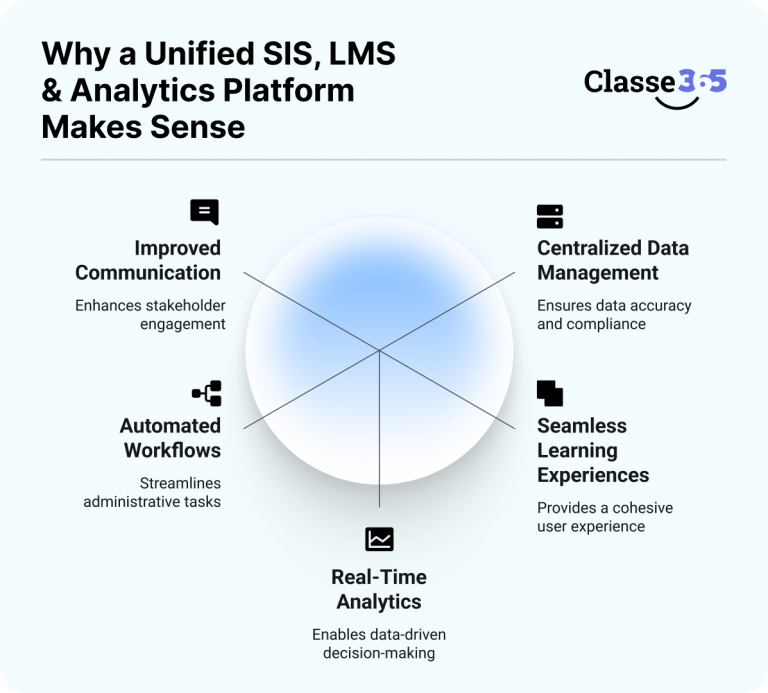Introduction: The Pitfalls of a Fragmented Education Tech Stack
Today’s schools operate in an increasingly digital landscape. But instead of driving efficiency, technology can sometimes add layers of complexity. It’s common to see institutions using one system for managing student records, another for delivering course content, and a third for performance analytics.
These disconnected systems create silos. Staff are forced to switch between interfaces, duplicate efforts, and chase data across platforms. The result? Time lost, morale drained, and insights delayed. With digital transformation in education accelerating, the time is ripe for integrated solutions that streamline operations from end to end.
Common Challenges of Disconnected School Systems
1. Time-Consuming Data Transfers
Manually exporting and importing files across platforms increases the risk of errors and drains staff productivity. Inconsistent formats or outdated spreadsheets add to the administrative burden.
2. Inconsistent Student Records
When SIS, LMS, and analytics tools operate in isolation, data discrepancies are inevitable. A student might appear as “John A. Doe” in one system and “Jonathan Doe” in another — causing confusion and flawed reporting.
3. User Fatigue Across Multiple Platforms
From teachers managing assignments to students checking grades, the need to toggle between systems impacts focus and productivity. This constant switching often leads to disengagement and missed updates.
4. Delayed Reporting and Insights
Administrative teams rely on timely data to make informed decisions. Without integration, compiling reports can take days, and the resulting insights may already be outdated by the time they’re shared.
5. Lack of Workflow Automation
Many schools still rely on manual processes for tasks like attendance tracking, fee reminders, and grade publishing. These repetitive actions eat into staff time and increase the chance of errors.

Why a Unified Platform Makes Sense
1. Centralized Data Management
A unified system ensures that student and staff data reside in a single source of truth. This reduces duplication, improves accuracy, and simplifies compliance reporting.
2. Seamless Learning Experiences
When LMS features are built into the same platform that manages student data, users benefit from a cohesive experience. Students can submit assignments, check grades, and receive feedback — all without juggling tabs.
3. Real-Time Analytics for Faster Decisions
Access to live data means administrators can monitor performance, attendance, and engagement as they happen. This enables faster intervention, more proactive planning, and data-backed decision-making.
4. Automated Workflows That Save Time
Admissions, fee collection, grade entry, and communication can all be automated in a unified system. These automations eliminate repetitive tasks and allow staff to focus on value-added responsibilities.
5. Improved Communication and Engagement
Targeted messaging via email, SMS, and in-app alerts helps ensure key updates reach the right stakeholders — whether it’s a parent receiving an attendance alert or a teacher sending assignment reminders.
A Real-World Impact: Unified Systems in Action
“A secondary school in Southeast Asia reduced admin workload by 40% and improved reporting accuracy by 60% within six months of switching to a unified platform.”
This is just one example of how integration translates into tangible results — from operational efficiency to better learning outcomes.
In Short (TL;DR):
- Stop switching between tabs — unify your school’s SIS, LMS, and analytics into one efficient system.
- Streamlined operations reduce manual tasks, improve reporting accuracy, and save time.
- Integrated platforms lead to better communication, faster decisions, and stronger student engagement.
- Discover how a unified approach to school management is transforming institutions worldwide.
Where Classe365 Comes In
If you’re ready to move away from juggling disconnected systems and want to manage your institution more efficiently, it may be time to explore an all-in-one solution.
Classe365 offers a unified education management platform that brings together SIS, LMS, and analytics under one roof — designed to simplify operations, enhance learning, and empower educators to do more with less.
Book a free demo and experience a smarter, more connected way to run your school.
Frequently Asked Questions
What are SIS, LMS, and analytics tools?
SIS (Student Information System) manages records, LMS (Learning Management System) handles course delivery, and analytics tools provide performance insights.
Why is integrating SIS, LMS, and analytics important?
Integration eliminates redundant data entry, enhances collaboration, and helps educators make timely, data-driven decisions.
What are the benefits of a unified education platform?
Faster workflows, improved data accuracy, stronger student engagement, and better institutional outcomes.
How do schools start transitioning to a unified platform?
Start by identifying overlapping tools, clarifying workflow pain points, and selecting a platform that offers seamless integration.
